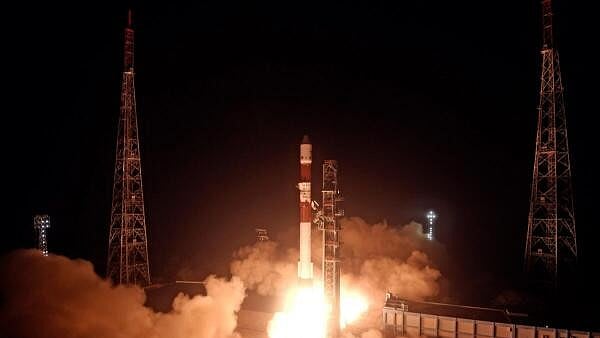
PSLV-C60 lifts off with SpaDeX spacecraft
Credit: PTI Photo
On December 30, the Indian Space Research Organisation (ISRO) ended 2024 on a high by successfully launching two small satellites on India’s first space docking experiment: SpaDeX. The twin satellites were carried into orbit atop a Polar Satellite Launch Vehicle (PSLV) rocket that lifted off from ISRO's Satish Dhawan Space Centre in Sriharikota.
The satellites — a ‘target’ and a ‘chaser’ — are currently in a low Earth orbit (LEO), moving one behind the other, and are expected to dock later this week which would make India only the fourth country in the world to master space docking after the United States, Russia, and China.
Christened Bharatiya Docking System (BDS), this indigenously developed technology is key to building a space station in LEO as well as for the next Moon mission, Chandrayaan-4, which will return lunar samples.
As ISRO chief S Somanath said: “Chandrayaan-4 has five modules, which will be launched at different times and integrated into two separate modules. These modules must reach orbit and dock in Earth and Moon orbit. Docking is essential for Chandrayaan-4. This mission aims to go to the Moon, land there, return to Earth, and complete the journey successfully.”
The BDS is one of several experiments (including a robotic arm to clear space debris and to grab damaged satellites and telescopes for service and repair) on board ISRO’s year-end mission. This happens to be the 99th rocket launch from the Sriharikota spaceport, and ISRO plans to follow it up with a ‘century’ launch later this month when the Geosynchronous Satellite Launch Vehicle (GSLV) puts the NVS-02 satellite into orbit.
The NVS-02 is part of the flock of Navigation with Indian Constellation satellites — similar to the Global Positioning System — that India is building to augment regional navigation capabilities. ISRO has also lined up a slew of other space missions in the year ahead.
ISRO crossed some major milestones last year, launching several satellites and the country’s maiden solar mission, Aditya, besides flight-testing a reusable launch vehicle and preparing the groundwork for India’s first manned spaceflight, Gaganyaan. The success of SpaDex adds to this list which shows how ISRO is ramping up its space endeavours by developing novel methods for advanced research. This approach has helped ISRO carry out missions that other space agencies failed to achieve, and it is now helping India compete more strongly in the global satellite launch market which is expected to touch $30 billion by 2027.
Currently ISRO earns only modest revenues from this lucrative market. This is despite leveraging its huge talent pool — and the increasing involvement of private industry in India’s space effort — to offer launch services at two-thirds of the price charged by other space agencies. ISRO may possess remarkable space capabilities ranging from world class launch systems and satellites to launching missions to the Moon and Mars. But the sad fact is that the space agency is hamstrung by the absence of a heavy lift launcher with which to expand its footprint in the global launch market.
Ever newer rockets of aerospace majors such as Space X, Northrop Grumman Corp, and United Launch Alliance of the US, Arianespace of France and the China Aerospace Science and Technology Corporation are constantly pushing the bar higher on payload capability. Even the most powerful booster built in India, the GSLV-LVM 3, has only a lift capacity of 10 tons to LEO and four tons to geostationary transfer orbit (GTO). This pales in comparison to other big launchers. For instance, SpaceX’s Falcon Heavy lofts 64 tons to LEO and 26 tons to GTO, while the Chinese Long March-5 can deliver 25 tons to LEO and 14 tons to GTO.
It is good to see the government finally acknowledging this handicap last September by giving the nod to the development of India’s Next Generation Launch Vehicle (NGLV). This is a welcome departure from the Department of Space’s earlier calculus where a super heavy lift launcher never figured.
The mega booster, expected to be operational by 2035, will be powered by green propulsion systems using fuel combinations such as methane-liquid oxygen. It will be partially reusable with some of the rocket components being recovered and re-flown. With three times the payload capacity of the GSLV-LVM 3, the NGLV will be capable of lofting 30 tons to LEO and 10 tons to GTO, cutting costs of space access.
ISRO will have to upgrade the existing launch facilities to accommodate the NGLV which necessitates a third launch pad at Sriharikota. ISRO sources say the new launch pad will be designed for the horizontal integration of the giant rocket that stands over 300 feet tall before tilting it up for the launch. So far, the practice at Sriharikota has been based on the vertical integration of rockets where the rocket stages were stacked one upon another in an assembly building and then transported to the launch pad.
The launch of SpaDex will likely add momentum to the NGLV project which is a key element of India’s Space Vision 2047 — a roadmap for the country’s space effort in the coming decades. The NGLV is essential not only for building India’s space station but to launch heavy satellites and the Chandrayaan missions that will establish habitats for future lunar settlers. Its successful development is, therefore, indispensable for India to occupy its position at the high table of space exploration.
(Prakash Chandra is former editor of the Indian Defence Review. He writes on aerospace and strategic affairs.)
Disclaimer: The views expressed above are the author's own. They do not necessarily reflect the views of DH.